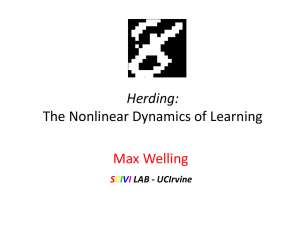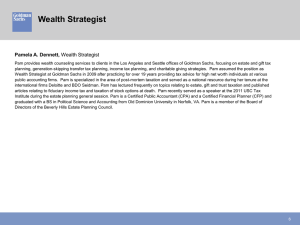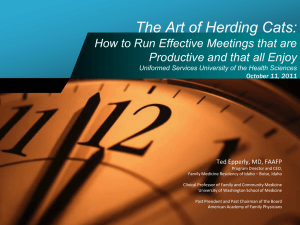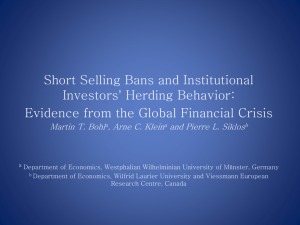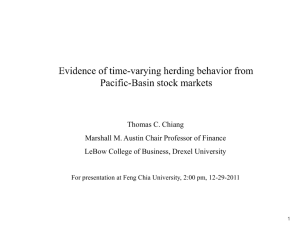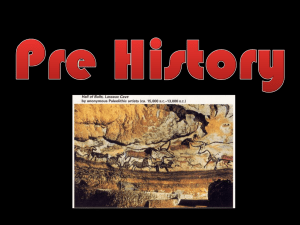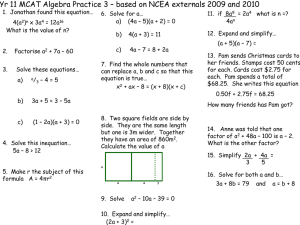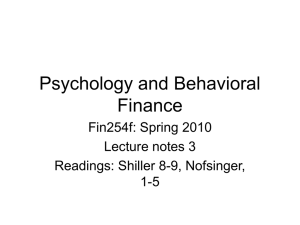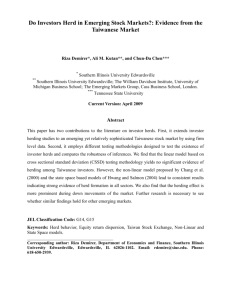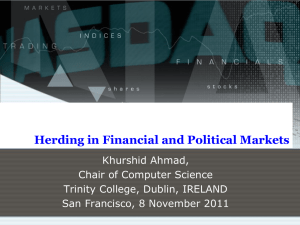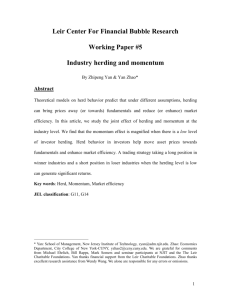Welling
advertisement
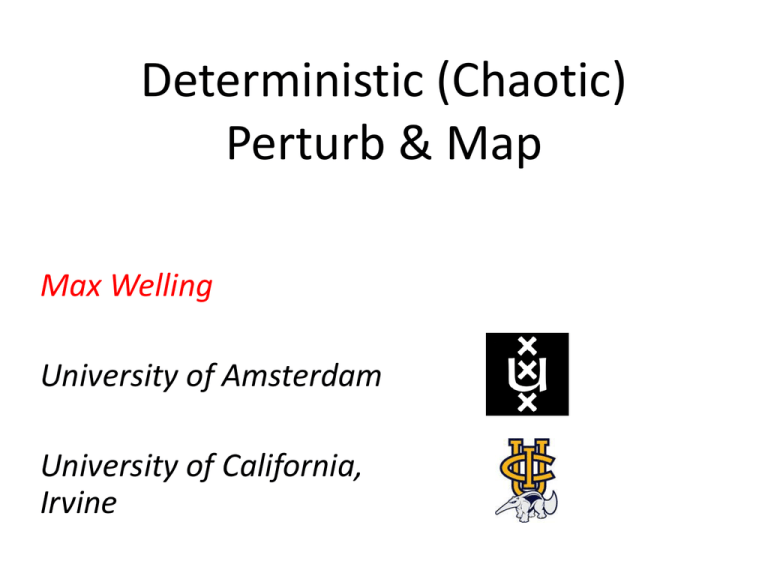
Deterministic (Chaotic)
Perturb & Map
Max Welling
University of Amsterdam
University of California,
Irvine
Overview
• Introduction herding though joint image segmentation and labelling.
• Comparison herding and “Perturb and Map”.
• Applications of both methods
• Conclusions
Example:
Joint Image Segmentation and Labeling
“people”
Step I: Learn Good Classifiers
• A classifier
P(yi | X)
: images features X object label y.
• Image features are collected in square window around target pixel.
Step II: Use Edge Information
• Probability
P(yi , y j | X) : image features /edges pairs of object labels.
• For every pair of pixels compute the probability that they cross an object boundary.
Step III: Combine Information
How do we combine classifier input and edge information into a segmentation algorithm?
We will run a nonlinear dynamical system to sample many possible segmentations
The average will be out final result.
The Herding Equations
Y
*
1 *
2 *
3 *
4
YY
Y
(y takes values {0,1} here for simplicity)
Y * ¬ argmax åWi yi + åWij yi y j
Y
i
ij
Wi ¬ Wi + P(yi | X) - yi*
Wij ¬ Wij + P(yi , y j | X) - yi* y*j
average
Some Results
ground
truth
local
classifiers
MRF
herding
Dynamical System
•
The map Wt+1 = F(Wt ) represents a weakly chaotic nonlinear dynamical system.
y=1
y=6
W2
y=2
y=5
y=3
Itinerary:
y=[1,1,2,5,2,…
y=4
W1
Geometric Interpretation
f (S1 )
f ( S2 )
w2
f (S5 )
wt
E pˆ [ f ]
wt 1
w1
f ( S4 )
S arg maxWk f k (S )
S
k
f (S3 )
Wk Wk EPˆ [ f k ] f k (S )
Convergence
Translation: v t = E Pˆ [ f ] - f k (St )
Choose St such that:
åW n =åW ( E
k k
k
k
k
Pˆ
)
[ f k ] - f k (S) £ 0
T
1
Then: | 1
f
(
s
)
E
[
f
]
|~
O
(
)
k t Pˆ k
T t 1
T
Equivalent to “Perceptron Cycling Theorem”
(Minsky ’68)
s=1
s=6
s=[1,1,2,5,2...
s=2
s=5
s=3
s=4
Perturb and MAP
Papandreou & Yuille, ICCV - 11
-Learn offset:
using moment
matching
State: s2
State: s3
State: s1
State: s4
State: s6
State: s5
-Use Gumbel PDFs
To add noise
PaM vs. Frequentism vs. Bayes
Given some likelihood P(x|w), how can you determine a predictive distribution P(x|X)?
Given dataset X, and sampling-distr. P(Z|X), a bagging frequentist will:
1. Sample fake data-set Z_t ~ P(Z|X) (e.g. by bootstrap sampling)
2. Solve w*_t = argmax_w P(Z_t|w)
3. Prediction P(x|X) ~ sum_t P(x|w_t*)/T
Given a dataset X, and prior P(w) Bayesian will:
1. Sample w_t~P(w|X)=P(X|w)P(w)/Z
2. Prediction P(x|X) ~ sum_t P(x|w_t)/T
Given a dataset X, and perturb-distr. P(w|X), a “pammer” will:
1. Sample w_t~P(w|X)
Herding uses deterministic,
2. Solve x*_t=argmax_x P(x|w_t)
chaotic perturbations instead
3. Prediction P(x|X) ~ Hist(x*_t)
Learning through Moment Matching
Papandreou & Yuille, ICCV - 11
PaM
Herding
PaM vs. Herding
Papandreou & Yuille, ICCV - 11
PaM
Herding
• PaM converges to a fixed point.
• PaM is stochastic.
• At convergence, moments are
matched:
• Convergence rate moments:
• In theory, one knows P(s)
• Herding does not converge to
a fixed point.
• Herding is deterministic (chaotic).
• After “burn-in”, moments are
matched:
• Convergence rate moments:
• One does not know P(s) but it’s
close to max entropy distribution.
Random Perturbations are Inefficient!
w0 R d , pi [0,1],
p
i
1
wi
i
st 1 argmaxwit
i
wi,t 1 wi,t ( pi [st 1,i])
Average Convergence of 100-state system with random probabilities
log-log plot
1
O
T
IID sampling from
multinomial distribution
herding
1
O
T
PaM
Sampling with
PaM / Herding
herding
Applications
Chen et al. ICCV 2011
herding
Conclusions
• PaM clearly defines probabilistic model, so one can
do maximum likelihood estimation [Tarlow. et al, 2012]
• Herding is a deterministic, chaotic nonlinear dynamical
system. Faster convergence in moments.
• Continuous limit is defined for herding (kernel herding)
[Chen et al. 2009]. Continuous limit for Gaussians also
studied in [Papandreou & Yuille 2010]. Kernel PaM?
• Kernel herding with optimal weights on samples =
Bayesian quadrature [Huszar & Duvenaud 2012]. Weighted PaM?
• PaM and herding are similar in spirit:
Define probability of a state as the total density in a certain
region of weight space. Both use maximization to compute
membership of a region. Is there a more general principle?
